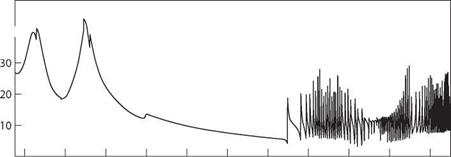Flying Rings around Saturn
At its closest approach to the Earth, Saturn is about eight times the Earth-Sun distance, or 800 million miles away. Yet, by the time Cassini reached Saturn it had traveled 2.2 billion miles. NASA launched Cassini with the best rocket available, but it wasn’t powerful enough to get the spacecraft to Saturn directly since it would be fighting against the Sun’s gravity all the way. So mission designers used gravity assist, colloquially called the gravitational “slingshot” mechanism, to get it to its target. As we saw in the last chapter with Voyager, this technique has been used since the 1970s to get nature’s help in hefting planetary probes away from the Sun’s gravity.24 The assist is provided by bringing the spacecraft alongside a planet from behind and letting it get a “kick” from the orbital angular momentum of the planet. In principle the spacecraft can get a speed boost of up to twice the planet’s orbital velocity.
Cassini passed by Venus twice, then the Earth, and finally Jupiter before heading to Saturn. The terrestrial flyby was controversial because of the nature of Cassini’s power source. Solar panels aren’t feasible for a mission so far from the Sun’s rays. So Cassini has three generators where radioactive decay of plutonium – 238 generates electricity via a thermocouple. The power source had raised congressional eyebrows before launch, but as the flyby approached, NASA was told to do an environmental impact assessment on the possibility of Cassini impacting the Earth. For a worst case scenario of a shallow angle of entry to the atmosphere and slow dispersal of the radioactive materials, the odds were one in 10 million.25 NASA was allowed to proceed. There were demonstrators and a few lawsuits, but the launch and flyby went off without a hitch and now the plutonium is at a safe distance of a billion miles.
These flybys were just a warm-up for the amazing series of gravitational dances that Cassini engaged in when it got to Saturn (figure 5.3). Over its core mission, Cassini orbited Saturn 140 times. To see Saturn, its rings, its largest moons, and its magnetosphere from all conceivable angles, Cassini is using its rockets and seventy gravity-assist flybys of Titan to tweak its orbit size, period, velocity, and inclination from Saturn. As the largest moon, Titan is
|
|
|

the most useful in “steering” Cassini around the Saturnian system. Each Titan flyby is engineered to return Cassini into the proper trajectory for its next Titan flyby. Encounters with other moons are performed opportunistically with what’s called a targeted flyby. About fifteen are planned by the end of the mission, half to the intriguing small moon Enceladus. From 2004 through 2011, Cassini did a dizzying hundred flybys, with another dozen completed in 2012. NASA hosts a clock counting down the time until the next swooping visit to a moon and coyly calls these “Tour Dates” to appeal to a younger generation.26 By clever planning, NASA engineers have doubled the length of the mission even though just a quarter tank of fuel remains.
Titan’s gravity has also been used to gradually tilt the inclination of Cassini’s orbit, allowing it to see the rings from above and below, and to see atmospheric phenomena of Saturn’s poles for the first time. Flybys of Titan can’t get closer than 600 miles, or the large moon’s thick atmosphere would slow the spacecraft. Some flybys to small moons have been as close as 15 miles. At a distance of a billion miles, that’s like hitting a golf ball coast to coast and dropping it within an inch of the hole! There’s another problem with operating such a remote probe. Depending on where Earth and Saturn are in their orbits, the distance between them can vary from eight to ten astronomical units or Earth-Sun distances. It therefore takes 70 to 85 minutes for radio commands to travel
from mission control to the spacecraft, and the same for the reverse journey. Controllers can’t give “real-time” commands. Even if they responded immediately to a problem, nearly three hours would pass before Cassini would get the response. This casts the flybys in an entirely new light, since the margin of error is less than a second.










